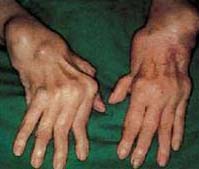Introduction
Although the term means joint inflammation, arthritis really refers to a group of more than 100 rheumatic diseases and conditions that can cause pain, stiffness and swelling in the joints. Examples include rheumatoid arthritis, gouty arthritis, septic arthritis etc.
The two commonest forms are osteoarthritis and rheumatoid arthritis.
What is rheumatoid arthritis?
Rheumatoid arthritis is an autoimmune disease that occurs when the body’s own immune system mistakenly attacks the synovium (cell lining inside the joint).
This chronic, potentially disabling disease causes pain, stiffness, swelling, and loss of function in the joints. Two to three times more women are affected than men.
This is an example of a rheumatoid hand which frequently affects patient with rheumatoid arthritis in the later stage.

What are the symptoms of rheumatoid arthritis?
Common symptoms include :
- Pain – due to inflammation of surrounding synovium or secondary osteoarthritis
- Loss of function – eg using toothbrush, hairbrush, knife, fork dressing
- Joint swelling and deformity (as shown above)
How is it treated?
For years, the pain and inflammation of arthritis have been treated with varying success, using medications, local steroid injections, and joint replacement.
Typical treatments for rheumatoid arthritis include :
- NSAIDs, such as ibuprofen or aspirin (which reduce swelling and alleviate pain but do not change the course of the disease).
- Disease-modifying anti-rheumatic drugs (DMARDs) such as methotrexate and sulfasalazine, also called slow-acting drugs. DMARDs work to slow inflammation and can, in many cases, alter the course of the disease. Now, most physicians use DMARDs early and aggresively in the hope of slowing disease progression and damage to joints and internal organs.
Can exercise help with arthritis?
Yes it can. Proper exercises performed on a regular basis are an important part of arthritis treatment. Not exercising causes weak muscles, stiff joints, reduced mobility, and loss vitality. Patients are now routinely advised a balance of physical activity and rest.
What types of exercises are recommended?
Three main types of exercises are recommended :
- Range-of-motion exercises: moving a joint as far as it will comfortably go and then stretching it a little further to increase and maintain joint mobility, decrease pain, and improve joint function. These can be done daily, or at least every other day.
- Strengthening: using muscles without moving joints to help increase muscle strength and stabilize weak joints. These can be done daily, or at least every other day, unless there is severe pain or swelling.
- Endurance: aerobic exercises such as walking, swimming and bicycling to strengthen the heart and lungs and increase stamina. These should be done for 20 to 30 minutes, three times a week, unless there is severe pain or swelling.
References
Campbell Operative Orthopaedics
| Last Reviewed | : | 01 May 2012 |
| Writer | : | Dr. Izan Ibrahim |
| Reviewer | : | Dr. Heselynn Hussein |







